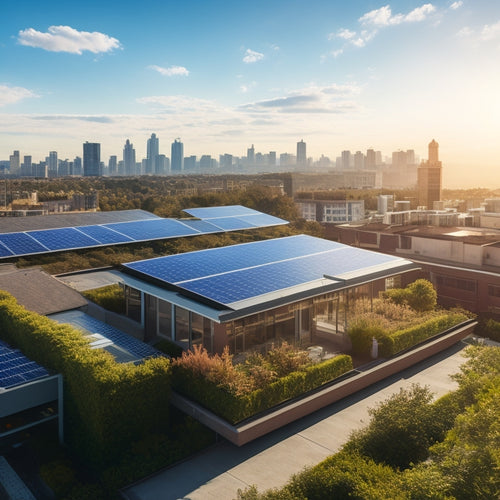
10 Essential Steps for Installing Solar Panels at Home
Share
You're about to initiate a quest to utilize the power of the sun and reduce your reliance on the grid by installing solar panels at home, and the first step is to understand the essential process involved in getting it right. Assess your home's energy needs by reviewing past electricity bills, conducting an energy audit, and implementing energy-efficient solutions. Determine solar panel requirements, choose the right panels, and select a compatible inverter. Plan the panel installation layout, prepare your roof, and install the mounting system and inverter. Connect the solar panels together, install the meter, and inspect and test the system. Now that you've got the basics covered, let's explore deeper into each step to guarantee a successful installation that maximizes your energy production and savings.
Key Takeaways
- Assess your home's energy needs by reviewing past electricity bills, conducting an energy audit, and implementing energy-efficient solutions.
- Determine the required solar panel size based on your energy needs, roof size, and local building codes.
- Choose high-efficiency solar panels that align with your energy needs and installation conditions, considering factors like warranties and durability.
- Ensure a compatible inverter is selected, oversized by 10-20% to account for potential energy losses, and verify its specifications.
- Plan the panel installation layout carefully, considering optimal panel orientation, shading analysis, and panel size, number, and spacing to maximize energy production.
Assess Your Home's Energy Needs
Before diving into the installation process, take a step back to assess your home's energy needs. Understanding your energy consumption is vital to maximizing the benefits of solar power. Start by reviewing your past electricity bills to identify patterns and peak usage periods. This will help you determine the size of the solar panel system you need.
Next, conduct an energy audit to identify areas of inefficiency in your home. Check for air leaks, insulation gaps, and inefficient appliances that drive up your energy consumption. Implementing energy-efficient solutions, such as LED lighting and Energy Star-rated appliances, will reduce your overall energy needs. This, in turn, will enable you to install a smaller solar panel system, saving you money on upfront costs.
Efficiency monitoring is also important to optimize your energy usage. Consider investing in a smart meter or energy monitoring system to track your energy consumption in real-time. This will help you identify opportunities to reduce your energy usage and maximize the benefits of your solar panel system.
Determine Solar Panel Requirements
You've assessed your home's energy needs and identified opportunities to reduce consumption. Now, it's time to determine the solar panel requirements for your installation. This involves calculating the size of the solar panel system you need, considering factors such as your energy usage, roof size, and local building codes.
To start, you'll need to determine the total amount of electricity your solar panel system needs to produce to meet your energy needs. This will depend on the type of solar panel you choose, as different types have varying levels of efficiency. For example, monocrystalline solar panels are more efficient than polycrystalline panels, but they're also more expensive.
Before you can begin installation, you'll need to obtain the necessary installation permits from your local government. These permits guarantee that your solar panel system meets safety and electrical codes.
Be sure to research the specific requirements for your area and factor in the time and cost of obtaining these permits into your overall installation plan.
Choose the Right Solar Panels
Selecting the right solar panels for your home installation is an essential decision that can greatly impact the performance and efficiency of your system. You need to take into account factors such as solar panel types, efficiency ratings, and durability to guarantee you get the most out of your investment.
There are three main types of solar panels: monocrystalline, polycrystalline, and thin-film. Each type has its pros and cons, which are summarized in the table below:
| Solar Panel Type | Efficiency Rating | Durability |
|---|---|---|
| Monocrystalline | 15-20% | High |
| Polycrystalline | 12-15% | Medium |
| Thin-film | 7-14% | Low |
When choosing solar panels, look for high-efficiency ratings, as they can generate more power per hour of sunlight. Additionally, take into account the warranty and durability of the panels, as well as any certifications they may have. By selecting the right solar panels for your home installation, you can guarantee a reliable and efficient source of renewable energy.
Select a Compatible Inverter
Match your solar panels with a compatible inverter to guarantee a seamless energy conversion process. This is a significant step in your solar panel installation, as the inverter plays an essential role in converting DC power from your solar panels into AC power for your home.
You'll need to take into account two key factors when selecting an inverter: inverter types and inverter sizing. There are three main inverter types: string inverters, microinverters, and power optimizers. String inverters are the most common, but microinverters and power optimizers offer more flexibility and monitoring capabilities.
When it comes to inverter sizing, you'll want to confirm the inverter can handle the maximum power output of your solar panel array. A general rule of thumb is to oversize the inverter by 10-20% to account for potential energy losses.
Be sure to check the inverter's specifications and consult with a professional if you're unsure about the sizing. By choosing the right inverter, you'll maximize your energy production and guarantee a reliable, efficient solar panel system.
Plan the Panel Installation Layout
Planning the panel installation layout is a critical step in guaranteeing your solar panel system operates at peak efficiency.
You'll need to determine the best panel orientation, factoring in the direction your roof faces and the surrounding environment. A south-facing orientation is ideal, but you can still achieve high efficiency with east- or west-facing panels.
Next, conduct a shading analysis to identify any obstructions that could impact energy production.
Consider the impact of trees, buildings, and other structures that may cast shadows on your roof. You can use online tools or consult with a professional to simulate shading patterns throughout the day and year.
Once you've accounted for orientation and shading, you can design a layout that maximizes energy production.
Consider the size and number of panels, as well as the spacing between them. A well-planned layout will guarantee your system generates the most power possible, reducing your reliance on the grid and saving you money on energy bills.
Prepare Your Roof for Installation
With your panel installation layout designed for maximum energy production, it's time to verify your roof is ready for the installation process. You need to assess your roof's condition, confirming it's structurally sound to support the solar panels' weight. Check for damaged, missing, or rotten roofing materials that could compromise the installation.
| Roof Assessment | Considerations | Actions |
|---|---|---|
| Roof Condition | Check for damage, rot, or missing materials | Repair or replace affected areas |
| Structural Integrity | Verify roof can support panel weight | Consult with a structural engineer if unsure |
| Shading Analysis | Identify potential shading issues | Trim trees or adjust panel layout accordingly |
Additionally, consider your roof's orientation and how it may impact energy production. Obtain installation permits and verify compliance with local regulations. Don't forget to factor in weather considerations, such as high winds or heavy snowfall, when selecting roofing materials. Finally, confirm maintenance access and implement safety measures to prevent accidents during the installation process. By addressing these critical factors, you'll be well-prepared for a successful solar panel installation.
Install the Mounting System
Get ready to anchor your solar panels securely by installing the mounting system. This critical step guarantees your solar panels remain in place, even in harsh weather conditions.
Begin by gathering all necessary mounting materials, including rails, clamps, and flashing. Next, inspect your roof's structure to determine the best placement of the mounting system, considering factors like roof orientation, pitch, and obstructions.
Using your installation tools, carefully attach the rails to your roof, verifying they're level and securely fastened. Then, install the clamps that will hold your solar panels in place. Make sure to follow the manufacturer's instructions and local building codes to avoid any potential issues.
Finally, apply flashing around the mounting system to create a watertight seal. By doing so, you'll protect your roof from water damage and guarantee a long-lasting, efficient solar panel system.
With the mounting system in place, you're one step closer to utilizing the power of the sun.
Connect the Solar Panels Together
You'll now connect the solar panels together to form a functional array.
This involves configuring the panels into strings, ensuring the correct voltage and current output for your system.
You'll need to carefully plan the array's layout to optimize energy production and meet the electrical requirements of your home.
Panel String Configuration
Your solar panel array is taking shape, and it's time to connect the individual panels together to form strings. This process, known as panel string configuration, is critical to optimize energy production and guarantee safe operation.
You'll need to decide between a series connection and a parallel connection, depending on your system's voltage optimization and current management requirements. A series connection increases voltage while keeping current constant, whereas a parallel connection increases current while maintaining voltage.
Consider panel efficiency and wiring techniques to minimize energy losses. Shading issues can also impact performance, so make certain your modular design takes this into account.
Always follow safety standards and use installation tools specifically designed for solar panel connections. Proper string configuration guarantees your system operates within specified parameters, maximizing energy output and reducing the risk of component failure.
Connecting the Array
With the panel string configuration complete, it's time to physically connect the solar panels together to form a cohesive array. You'll need to employ proper cabling techniques to guarantee safe and efficient energy transmission.
Begin by connecting the positive and negative terminals of each panel, following the manufacturer's guidelines for wire size and type. Make certain to secure the cables with cable ties or clamps to prevent damage or disconnection.
As you connect the panels, take necessary safety measures to avoid electrical shock or injury. Wear protective gear, including gloves and safety glasses, and confirm the system is de-energized before making any connections.
Verify that the voltage and current ratings of the cables match the system's requirements. Properly label and organize the cables to facilitate easy maintenance and troubleshooting.
Once the array is connected, perform a visual inspection to verify all connections are secure and meet the manufacturer's specifications. Confirm that the system is properly grounded and that all components are installed according to local electrical codes.
With the array connected, you're one step closer to utilizing the power of the sun and reducing your reliance on the grid.
Install the Inverter and Meter
Across from the solar panel array, the inverter and meter await installation, marking an essential step in utilizing the energy generated by your solar panels.
You'll need to choose the right inverter type for your system - string inverters, microinverters, or power optimizers - depending on your specific setup and energy needs. Once you've selected the inverter, it's time for installation.
Mount the inverter in a well-ventilated area, making sure it's easily accessible for maintenance and monitoring.
Next, focus on meter installation. You'll need to connect the meter to the inverter output, which measures the energy production of your solar panels.
Verify the meter is installed in accordance with local electrical codes and regulations. A net meter, specifically, will measure the difference between the energy produced by your solar panels and the energy consumed by your home, allowing you to sell excess energy back to the grid.
With the inverter and meter in place, you're one step closer to utilizing the power of the sun and reducing your reliance on traditional energy sources.
Inspect and Test the System
You'll now need to inspect and test the entire system to verify it's functioning as expected.
This involves performing a system performance check to identify any potential issues, verifying that all panels are properly connected, and analyzing the energy output to confirm it meets your requirements.
System Performance Check
Your newly installed solar panel system is now ready for a thorough system performance check. This vital step guarantees your system is generating power efficiently and safely.
You'll need to inspect the entire system, from the panels to the inverter and electrical connections, to identify any potential issues. Start by verifying the system's voltage, current, and power output match the manufacturer's specifications.
Next, inspect the system's monitoring system, which tracks performance and alerts you to any problems. Regular performance monitoring is fundamental for ideal system maintenance.
You should also check the system's grounding and bonding, confirming it meets electrical safety standards. Finally, review the system's performance data to identify any trends or anomalies that may indicate a problem.
Panel Connection Verification
During the system performance check, verifying panel connections is an essential step to guarantee the solar panel system operates efficiently and safely. You must confirm that all electrical connections are secure, proper, and meet wiring standards. Failure to do so can lead to system malfunction, electrical shock, or even fires.
Take your time to inspect each connection, paying attention to signs of wear, corrosion, or overheating. Check for loose or damaged wires, and verify that all connectors and terminals are securely fastened.
It's vital to follow safety precautions when handling electrical components, so make certain you're wearing protective gear, such as gloves and safety glasses.
Use a multimeter to test the voltage and current output of each panel, and compare the readings to the manufacturer's specifications. This will help you identify any potential issues or defects.
Remember to consult your system's documentation and diagrams to guarantee accurate testing and verification. By thoroughly inspecting and testing your panel connections, you'll be able to identify and address any problems before they become major issues, making certain your solar panel system operates at peak performance and safety.
Energy Output Analysis
Efficiency is the lifeblood of a solar panel system, and energy output analysis is the key to revealing its full potential.
You've installed the panels, connected them, and now it's time to inspect and test the system to guarantee optimal performance. This vital step helps you identify any issues, adjust settings, and fine-tune the system for maximum solar energy efficiency.
You'll need to test the photovoltaic performance of each panel, checking for any defects, misalignments, or obstructions.
Verify that the system is producing the expected amount of power, and make adjustments as needed. This involves monitoring voltage, current, and power output, as well as inspecting the system's electrical connections and wiring.
Frequently Asked Questions
Can I Install Solar Panels Myself to Save Money?
You're considering a DIY installation to reap cost savings, but be warned: without proper knowledge, you'll likely void warranties, compromise efficiency, and even risk safety hazards, ultimately negating any potential savings.
How Long Does a Typical Solar Panel Warranty Last?
You'll typically enjoy 25-30 years of warranty coverage, which mirrors the average solar panel lifespan, ensuring you reap the benefits of clean energy while shielding yourself from premature degradation and costly repairs.
Do Solar Panels Work During Power Outages?
When the grid goes dark, you're left in the dark, but solar panels can be your guiding light. During power outages, you can still utilize the sun's energy, but only if you've got a battery backup system installed, ensuring continuous solar panel functionality.
Are Solar Panels Affected by Shade From Trees or Buildings?
You'll find that solar panels' efficiency takes a hit when shaded by trees or buildings, as even partial shading can greatly reduce energy output, so you'll want to carefully assess and mitigate the shading impact on your solar panel system.
Can I Add More Solar Panels to My System Later?
Imagine your solar array as a powerful, scalable machine; you can easily expand its capacity by adding more panels later, as long as your system's compatibility allows it, and your energy needs continue to grow.
Related Posts
-

Why Go Green With Automotive Products Online?
By switching to eco-friendly automotive products online, you're taking a significant step towards reducing your carbo...
-

Charging Points in Rural Areas: 5 Key Insights
When driving through rural areas, you'll face a shortage of charging points, making EV ownership stressful and inconv...
-

What Is the Cost to Put in Solar Panels
You're likely considering solar panels for your home, and the most significant factor in your decision is the upfront...


